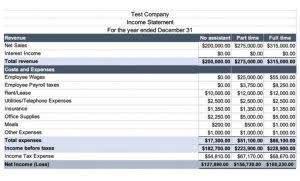US GAAP vs IFRS Differences + Cheat Sheet PDF

11 Financial’s website is limited to the dissemination of general information pertaining to its advisory services, together with access to additional investment-related information, publications, and links. https://www.bookstime.com/ Finance Strategists has an advertising relationship with some of the companies included on this website. We may earn a commission when you click on a link or make a purchase through the links on our site.
The sum of all debits must always equal the sum of all credits in a trial balance report. For instance, if you delivered goods worth $5,000 on the last day of the month but didn’t receive the amount until the next accounting period, then you’ll need to adjust your journal entry. Update your accounts by making such adjusting entries in the general journal. This article is for anyone who wants to understand how to prepare a balance sheet, which is often used by investors, creditors, and management. We explain why and how to create one as well as suggest technology tools to simplify your job.
What is order of liquidity and order of permanence related to balance sheet?
In our example, the number for total assets at year-end 2020 would overstate the amount and distort the return on assets ratio (net income/total assets). How assets are supported, or financed, by a corresponding growth in payables, debt liabilities and equity reveals a lot about a company’s financial health. For now, suffice it to say that depending on a company’s line of business and industry characteristics, possessing a reasonable mix of liabilities and equity is a sign of a financially order of liquidity healthy company. A company’s financial statements—balance sheet, income, and cash flow statements—are a key source of data for analyzing the investment value of its stock. Stock investors, both the do-it-yourselfers and those who follow the guidance of an investment professional, don’t need to be analytical experts to perform a financial statement analysis. Today, there are numerous sources of independent stock research, online and in print, which can do the “number crunching” for you.
This balance sheet compares the financial position of the company as of September 2020 to the financial position of the company from the year prior. Different accounting systems and ways of dealing with depreciation and inventories will also change the figures posted to a balance sheet. Because of this, managers have some ability to game the numbers to look more favorable.
Methods of Arranging Assets and Liabilities:
For example, imagine a company reports $1,000,000 of cash on hand at the end of the month. Without context, a comparative point, knowledge of its previous cash balance, and an understanding of industry operating demands, knowing how much cash on hand a company has yields limited value. The balance sheet is a very important financial statement for many reasons. It can be looked at on its own and in conjunction with other statements like the income statement and cash flow statement to get a full picture of a company’s health. There are some key differences between how corporate finances are governed in the US and abroad. Understanding GAAP and IFRS guidelines can be an asset, no matter your profession or industry.
- The traditional business model in the automotive industry has gradually begun to shift from one-time purchases to continuous post-sale revenue.
- To conclude our section on how US GAAP and IFRS differ, another area of variance is the information required to be disclosed within the footnotes of the financial statements, as well as the terminology frequently found in filings.
- Long-term liabilities, on the other hand, are due at any point after one year.
- Shareholder equity is the money attributable to the owners of a business or its shareholders.
For small privately-held businesses, the balance sheet might be prepared by the owner or by a company bookkeeper. For mid-size private firms, they might be prepared internally and then looked over by an external accountant. The image below is an example of a comparative balance sheet of Apple, Inc.
US GAAP vs IFRS: Measurement of Accounting Elements
The ordering of the items in a balance sheet (assets and liabilities) is called marshalling. To serve this purpose, assets and liabilities are recorded on the balance sheet in a specific order. This order of assets and liabilities on the balance sheet is called marshalling.
However, there are several “buckets” and line items that are almost always included in common balance sheets. We briefly go through commonly found line items under Current Assets, Long-Term Assets, Current Liabilities, Long-term Liabilities, and Equity. On the right side, the balance sheet outlines the company’s liabilities and shareholders’ equity. Assets represent things of value that a company owns and has in its possession, or something that will be received and can be measured objectively. Liabilities are what a company owes to others—creditors, suppliers, tax authorities, employees, etc.


 Rəsmi Saytı 202 Our Lady Of The Pillar College Cauayan – 688
Rəsmi Saytı 202 Our Lady Of The Pillar College Cauayan – 688